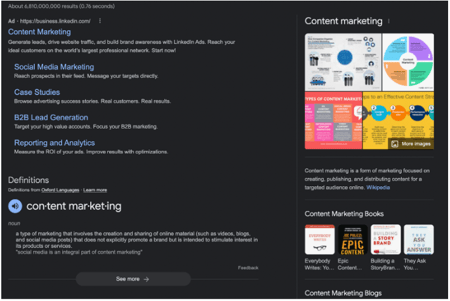The biggest gift you might be able to give your customers and prospects right now—and one that might create more trust in the long run—is to not ask them to do anything in order to get your content.
-
Don’t ask them for their phone number.
-
Don’t ask them for their email address.
-
Don’t even ask them to click on your call to action.

Okay, let me back up a bit. As an organization, you know how important it is to invest in a sound content marketing strategy. Relevant content educates and informs your audience, and it also builds brand awareness and demand for your products.
Because of content marketing’s importance, you’ve poured a fair amount of time and money into creating high-quality content pieces to entice your target audience. Articles, videos, one-pagers, ebooks, huge research studies—you’ve done it all. Then, there are the expertly crafted landing pages that guard those goods, and the calls to action that were written specifically to entice a click.
That’s why it’s always especially heartbreaking when even the best content underperforms. But lately, I think it’s less about content marketing “not working” and more about something that we experience as consumers, but as marketers don’t always want to admit: that content fatigue, especially at this present moment, is real. Very real.
I’ll admit it: I’m suffering from a chronic case of content fatigue right now. I want information. I want new ways of thinking. I want the stuff. But I don’t want to do the usual marketing actions to get the stuff.
I don’t want to have to click on a call to action that takes me to a webpage when I was perfectly happy scrolling through LinkedIn a moment before. I don’t want to have to fill out a long form—or even a short one—to get an on-demand webinar recording.
I want the information I need, on the platform I’m already on. I want to get my new insights and ways of thinking in zero clicks. And our customers do, too.
Zero-click content: Everything marketers were told NOT to do now makes the most sense.
Zero-click content, as SparkToro VP of Marketing Amanda Natividad says, is content that keeps people on the site they’re already on instead of sending them to yours.
I’m suffering from a chronic case of content fatigue right now.
I can already sense the jaw-drops from some of my old-school marketing pals. “Don’t build a house on real estate you don’t own” used to be Marketing 101. Not too long ago, the worst action you could take as a marketer was to build your content strategy on a platform that wasn’t your own website. Sure, have a social media presence, but always make sure you’re taking them to your own property.
If that was Marketing 101, “never give away your best information for free” was Marketing 102. If you had “proven strategies,” or ‘must-have tech insights,” it was imperative that you get your prospects to register for a webinar or download an ebook to get the goods. You certainly didn’t give away anything without something in return, i.e. names, phone numbers, and emails to put in your marketing funnel.
Times have changed, and it’s not just the consumer content fatigue that’s responsible. There’s also the fact that the social media platforms you use to build your brand and generate demand—LinkedIn, Twitter, Facebook, Instagram—are prioritizing native content. If you actively post on LinkedIn, you may see this phenomenon first-hand. When you post, do you expect someone to click through to your website, a landing page, or a form—or do you expect them to absorb the message you’re offering right then and there?
It’s not just social media. SparkToro founder Rand Fishkin published a body of research last year where he noticed that between January and December 2020, nearly 65% of Google searches ended without a click to another web property, up from 50% in June 2019. It’s because Google started to insert definitions into the first page of Google search results.
Try this for yourself—Google the term “content marketing.” Here’s what came up for me:

The way to gain trust and authority with both customers AND platforms seems to be to give them both what they want—and that’s through zero-click content. But how do you do that without completely upending your own content marketing strategy?
Keep creating content, but think differently about promotion.
Whenever a new marketing idea like this bubbles to the surface, marketing teams either ignore it completely or reorient the entire approach. As usual, the true solution is somewhere in the middle.
Zero-click content doesn’t mean we stop producing content.
Zero-click content doesn’t mean we stop producing content. It doesn’t even mean we should stop producing long-form content. Those assets still have their place and purpose in the buying cycle. What I am suggesting is that we revise our approach to how we put it out into the world.
One way to do this is to take away the noise and promote the best parts of a content asset in bite-sized pieces. I do this often with my own content. For example, let’s say your team has a 1,000-word blog post (like this one). You could:
-
Break the content up into three 200-300 word LinkedIn posts—one to introduce the idea of zero-click content, one to talk about why it matters, and one to talk about the tactical how-to of doing it. To show the platform you’re not trying to take anyone away, put the link to the full blog posts in the comments of the posts.
-
Next, distill the most important pieces into a 10-part tweet digest (ten consecutive tweets that you number) and put it on Twitter.
-
Third, consider breaking down the blog’s most important points through a series of Instagram stories.
-
Finally, use the blog post to write an email series that gives your audience all the information without sending them to your website to read the full blog.
Experimenting with zero-click content doesn’t mean your longer-form assets never see the light of day. You can still put that piece on your website, or send it out as a newsletter (you’re there now!) Zero-click content means your audience has different (and easier) ways to consume your content and get the information you’re offering.
Wait. What about leads?
Leads are important, and zero-click content is not going to decrease them. In fact, they’ll most likely increase.
Killing the click is scary, counterintuitive, and uncomfortable.
If you’re creating great content, and you’re making that content available across the platforms your audience is already spending time on, in a variety of different asset types, that’s an awareness-building approach that will eventually warm up engaged audiences to the point where they’re ready to talk to you.
And, by recognizing their fatigue, your brand is going to build positive sentiment with your prospects much quicker than your competitors, who are still swimming in the red ocean of too many clicks and asks.
Killing the click is scary, counterintuitive, and uncomfortable. It also might be the best action we can take to meet our customers where they are.
See our YouTube channel, Marketing Air-Cover, for additional guidance on marketing strategy for small businesses.
Learn more about hiring a fractional CMO here.








